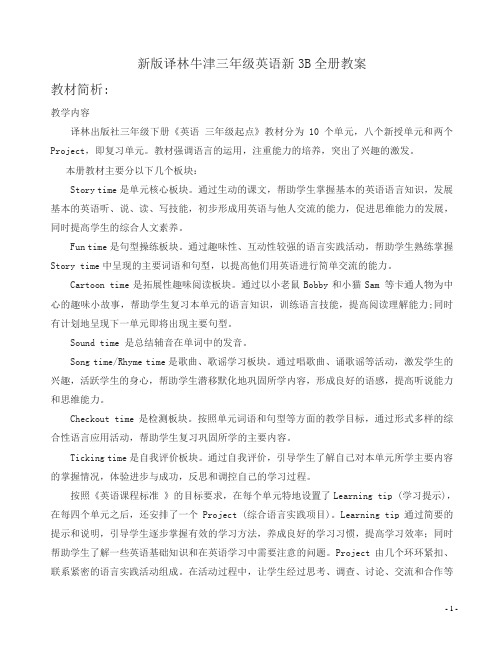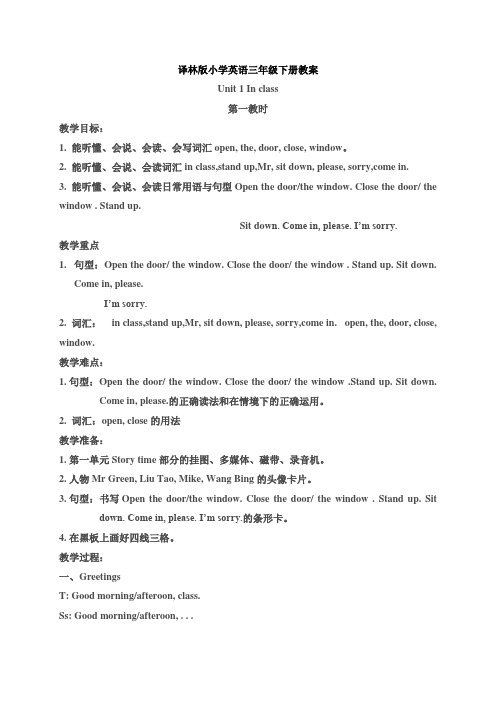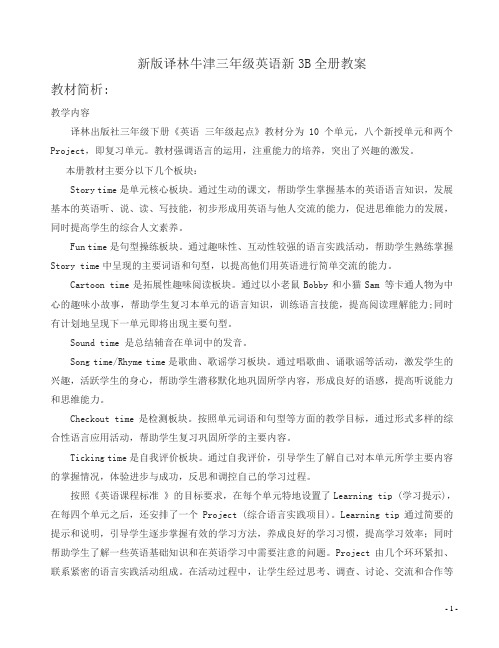2018年牛津译林版3B英语三年级下册全册教案
- 格式:doc
- 大小:297.00 KB
- 文档页数:62

新版译林牛津三年级英语新3B全册教案教材简析:教学内容译林出版社三年级下册《英语三年级起点》教材分为10个单元,八个新授单元和两个Project,即复习单元。
教材强调语言的运用,注重能力的培养,突出了兴趣的激发。
本册教材主要分以下几个板块:Story time是单元核心板块。
通过生动的课文,帮助学生掌握基本的英语语言知识,发展基本的英语听、说、读、写技能,初步形成用英语与他人交流的能力,促进思维能力的发展,同时提高学生的综合人文素养。
Fun time是句型操练板块。
通过趣味性、互动性较强的语言实践活动,帮助学生熟练掌握Story time中呈现的主要词语和句型,以提高他们用英语进行简单交流的能力。
Cartoon time是拓展性趣味阅读板块。
通过以小老鼠Bobby和小猫Sam 等卡通人物为中心的趣味小故事,帮助学生复习本单元的语言知识,训练语言技能,提高阅读理解能力;同时有计划地呈现下一单元即将出现主要句型。
Sound time 是总结辅音在单词中的发音。
Song time/Rhyme time是歌曲、歌谣学习板块。
通过唱歌曲、诵歌谣等活动,激发学生的兴趣,活跃学生的身心,帮助学生潜移默化地巩固所学内容,形成良好的语感,提高听说能力和思维能力。
Checkout time是检测板块。
按照单元词语和句型等方面的教学目标,通过形式多样的综合性语言应用活动,帮助学生复习巩固所学的主要内容。
Ticking time是自我评价板块。
通过自我评价,引导学生了解自己对本单元所学主要内容的掌握情况,体验进步与成功,反思和调控自己的学习过程。
按照《英语课程标准》的目标要求,在每个单元特地设置了Learning tip (学习提示),在每四个单元之后,还安排了一个Project (综合语言实践项目)。
Learning tip通过简要的提示和说明,引导学生逐步掌握有效的学习方法,养成良好的学习习惯,提高学习效率;同时帮助学生了解一些英语基础知识和在英语学习中需要注意的问题。

牛津译林版英语三年级下册教案全册第一单元2. Please think and fill in the blanks. (PPT 呈现)3. You all did very well. In this lesson, we’ve learnt how to give orders, such as: Sit down, please./Liu Tao, please open the door.(祈使句用来表示请求或命令别人做某事或不要做某事。
)4. Make dialoguesT: Can you use the new sentences to make dialogues? At school or athome. You can choose one to make a dialogue.【设计意图:通过学生练习,明确用法,让生初步接触祈使句的概念。
】Homework 家庭作业1. Read the dialogue after the tape and imitate the pronunciation.2. Try to use new words “please open … /close … /sit down./stand up.” in your life.Teaching aids 教学准备(含板书设计)板书设计:Unit 1 HelloI’m sorry.祈使句:Stand up.Sit down.Open the door.Close the window.Come in, please.记:在本节课以歌曲导入,让学生快乐地大声唱英语歌曲不仅能营造英语学习的氛围,也带动学生课堂开始的热情,为开始新课做好准备。
接下来结合现实情境教学Stand up./Sit down, please.并采用“做小老师”的游戏形式体会和巩固句型。
在课文学习部分,让学生先通过看卡通,整体感知文本,并找出是谁迟到了,培养学生听故事的能力。

Unit 1 In classThe first period一、教学内容:Story time.二、教学目标:1、使学生能听懂、会说、会运用词汇:door.2、使学生能听懂、会说、会运用祈使句:Stand up. Sit down. Open/ Close the door.3、使学生能正确地连读祈使句:Stand up.三、教学重点:1、使学生能听懂、会说、会运用词汇:door.2、使学生能听懂、会说、会运用祈使句:Stand up. Sit down. Open/ Close the door.四、教学难点:1、祈使句Stand up.的连读。
2、词汇open 和close 学生容易混淆。
五、教学准备:歌曲《Stand up》; door的图片。
六、教学过程:Step 1. Greeting.T: Good morning, class.S: Good morning, …Step 2. Leading in: Listen to a song: Stand up.Step 3. Teaching the sentence: Stand up.1. Lead Ss to find the new sentence in the song, then write it on the blackboard.2. Lead Ss to read it by themselves.3. Teach Ss to read it, then choose someone to read one by one.4. Teacher does the action, lead Ss to guess the meaning of it.5. Listen to the song again, try to sing it.6. Sing after the computer sometimes.(The students only sing the sentence: Stand up. The teacher sings the others.)76. Sing it without the music.87. Ss sing it in pairs.9. Choose some pairs to sing.10. Teach Ss to(连读)Step 4. Teaching the sentence: Sit down.1. Write the sentence on the blackboard, then lead Ss to read it by themselves.2. Teach Ss to read it, then choose someone to read one by one.3. Teacher does the action, lead Ss to guess the meaning of it.4. Give Ss the music, ask them to try to use this sentence instead of …Sit down‟, then sing the song again.(Two times)5. Ss try to sing the song together.(Two times)6. Choose some groups to sing.Step 5. Practice the two sentences.1. Lead Ss to sing the song with the two sentences.First, ask Ss try to sing in groups, then sing it together. At last, choose some groups to sing together.2. Lead Ss to know the meaning of the four words: stand sit, up down.3. Ss read the words one by one. At the same time, teach Ss to do the action of them.Step 6. Teach these words: open, close, door.1. Teach the word: door.(1). Show Ss the card of the word, then ask Ss to try to read it by themselves.(2). Teach Ss to read it some times.2. Teach the words: open, close.(1).Write the two words on the blackboard, then ask Ss to try to read them by themselves.(2).Teach Ss to read them some times.(3). Do an exercise: Read and match.open 关上close 打开(4). Help Ss to remember the two words.3. Practice.(1). Make phrases with the three words.(2). Sing the song …Stand up.‟ with the two sentences: Open the door. Close the door.Step 7. Consolidation.Sing the song …Stand up.‟ with the four sentences: Stand up. Sit down. Open the door. Close the door.1. Give Ss some minutes to sing it in groups.2. Ss sing it together.3. Choose some groups to sing.Homework: Sing the song …Stand up.‟ with the four sentences: Stand up. Sit down. Open the door. Close the door.板书设计:Unit 1 In classStand up.Sit down.Openthe door .CloseThe second period一、教学内容:Story time.二、教学目标:1、使学生能听懂、会说、会运用词汇:a window, a blackboard, Mr, please.2、使学生能听懂、会说、会运用句型:I‟m sorry. Come in, …3、使学生能正确的理解并朗读故事。

新版译林牛津三年级英语新3B全册教案教材简析:教学内容译林出版社三年级下册《英语三年级起点》教材分为10个单元,八个新授单元和两个Project,即复习单元。
教材强调语言的运用,注重能力的培养,突出了兴趣的激发。
本册教材主要分以下几个板块:Story time是单元核心板块。
通过生动的课文,帮助学生掌握基本的英语语言知识,发展基本的英语听、说、读、写技能,初步形成用英语与他人交流的能力,促进思维能力的发展,同时提高学生的综合人文素养。
Fun time是句型操练板块。
通过趣味性、互动性较强的语言实践活动,帮助学生熟练掌握Story time中呈现的主要词语和句型,以提高他们用英语进行简单交流的能力。
Cartoon time是拓展性趣味阅读板块。
通过以小老鼠Bobby和小猫Sam 等卡通人物为中心的趣味小故事,帮助学生复习本单元的语言知识,训练语言技能,提高阅读理解能力;同时有计划地呈现下一单元即将出现主要句型。
Sound time 是总结辅音在单词中的发音。
Song time/Rhyme time是歌曲、歌谣学习板块。
通过唱歌曲、诵歌谣等活动,激发学生的兴趣,活跃学生的身心,帮助学生潜移默化地巩固所学内容,形成良好的语感,提高听说能力和思维能力。
Checkout time是检测板块。
按照单元词语和句型等方面的教学目标,通过形式多样的综合性语言应用活动,帮助学生复习巩固所学的主要内容。
Ticking time是自我评价板块。
通过自我评价,引导学生了解自己对本单元所学主要内容的掌握情况,体验进步与成功,反思和调控自己的学习过程。
按照《英语课程标准》的目标要求,在每个单元特地设置了Learning tip (学习提示),在每四个单元之后,还安排了一个Project (综合语言实践项目)。
Learning tip通过简要的提示和说明,引导学生逐步掌握有效的学习方法,养成良好的学习习惯,提高学习效率;同时帮助学生了解一些英语基础知识和在英语学习中需要注意的问题。

译林版小学英语三年级下册教案Unit 1 In class第一教时教学目标:1. 能听懂、会说、会读、会写词汇open, the, door, close, window。
2. 能听懂、会说、会读词汇in class,stand up,Mr, sit down, please, sorry,come in.3. 能听懂、会说、会读日常用语与句型Open the door/the window. Close the door/ the window . Stand up.Sit dow n. Come in, please. I‟m sorry.教学重点1.句型:Open the door/ the window. Close the door/ the window . Stand up. Sit down.Come in, please.I‟m sorry.2. 词汇:in class,stand up,Mr, sit down, please, sorry,come in. open, the, door, close, window.教学难点:1. 句型:Open the door/ the window. Close the door/ the window .Stand up. Sit down.Come in, please.的正确读法和在情境下的正确运用。
2. 词汇:open, close的用法教学准备:1. 第一单元Story time部分的挂图、多媒体、磁带、录音机。
2. 人物Mr Green, Liu Tao, Mike, Wang Bing的头像卡片。
3. 句型:书写Open the door/the window. Close the door/ the window . Stand up. Sitdown. Come in, please. I‟m sorry.的条形卡。

新版译林牛津三年级英语新3B全册教案教材简析:教学内容译林出版社三年级下册《英语三年级起点》教材分为10个单元,八个新授单元和两个Project,即复习单元。
教材强调语言的运用,注重能力的培养,突出了兴趣的激发。
本册教材主要分以下几个板块:Story time是单元核心板块。
通过生动的课文,帮助学生掌握基本的英语语言知识,发展基本的英语听、说、读、写技能,初步形成用英语与他人交流的能力,促进思维能力的发展,同时提高学生的综合人文素养。
Fun time是句型操练板块。
通过趣味性、互动性较强的语言实践活动,帮助学生熟练掌握Story time中呈现的主要词语和句型,以提高他们用英语进行简单交流的能力。
Cartoon time是拓展性趣味阅读板块。
通过以小老鼠Bobby和小猫Sam 等卡通人物为中心的趣味小故事,帮助学生复习本单元的语言知识,训练语言技能,提高阅读理解能力;同时有计划地呈现下一单元即将出现主要句型。
Sound time 是总结辅音在单词中的发音。
Song time/Rhyme time是歌曲、歌谣学习板块。
通过唱歌曲、诵歌谣等活动,激发学生的兴趣,活跃学生的身心,帮助学生潜移默化地巩固所学内容,形成良好的语感,提高听说能力和思维能力。
Checkout time是检测板块。
按照单元词语和句型等方面的教学目标,通过形式多样的综合性语言应用活动,帮助学生复习巩固所学的主要内容。
Ticking time是自我评价板块。
通过自我评价,引导学生了解自己对本单元所学主要内容的掌握情况,体验进步与成功,反思和调控自己的学习过程。
按照《英语课程标准》的目标要求,在每个单元特地设置了Learning tip (学习提示),在每四个单元之后,还安排了一个Project (综合语言实践项目)。
Learning tip通过简要的提示和说明,引导学生逐步掌握有效的学习方法,养成良好的学习习惯,提高学习效率;同时帮助学生了解一些英语基础知识和在英语学习中需要注意的问题。
新牛津英译林版三年级英语下册全册教案3bunit1inclass教学目标:3.能听懂,会说,会读、会写open,the,door,window,book4.学诵读歌谣:openthewindow.5.能够准确地理解、说话和发音。
单词中字母B的发音教学重点1.词汇mr,door,window,open,close,blackboard,rubber,ruler,please,parrot,don’t=donot多媒体和教学准备卡period1教学目标:1.能听懂,会说,会读mr,door,window,open,close.2.能够理解、说话和阅读站立、坐下打开门、关上窗户3。
学会使用礼貌用语:请教授要点:1.能听懂,会说,会读mr,door,window,open,close.2.能够理解、说话和阅读站立、坐下打开门、关上窗户3。
学习使用礼貌用语:取悦教学的困难1.能听懂,会说,会读mr,door,window,open,close.2.能够理解、说话和阅读站立、坐下开门和关窗的教学过程:步骤1:热身2.singasong:followmet:icansing.canyousing?s:yes,ican.3.freetalk.step2presentat ion:1.听这首歌跟着我,教他们站起来坐下t:youcansing,andyoucansingverywell.let’senjoyasingnow.t:whatcanyoulearnfromit?让学生说说从歌曲里听到了什么?(1)教授词组:standup个别读小组读全班读(2)教授短语:坐下个人阅读小组阅读全班阅读2游戏名称:actandsay:看ppt提示单词,做动作,并且大声读出来。
lookatme:根据教师说的词组,做动作,说词组guessinggame:图片遮去部分,猜是什么。
3.storytime教学(1)引导问题-单元1包含类出示storytime图片,让学生猜他们在哪里。
牛津译林版三年级英语下册全册教案一、教学内容本教案基于牛津译林版三年级英语下册,共包含五个单元。
具体章节和内容如下:1. Unit 1 In classLesson 1: We're looking for it.Lesson 2: What's this? It's a red hat.Lesson 3: Can you help me? Sure.2. Unit 2 My familyLesson 4: This is my mother.Lesson 5: He's my brother.Lesson 6: She's a doctor.3. Unit 3 At the zooLesson 7: Look at the猴子.Lesson 8: That's a funny elephant.Lesson 9: The tiger is sleeping.4. Unit 4 Time for bedLesson 10: It's time for breakfast.Lesson 11: It's time for lunch.Lesson 12: It's time for bed.5. Unit 5 Plus and minusLesson 13: What's two and three?Lesson 14: What's five minus two?Lesson 15: How many?二、教学目标1. 掌握本册书中的重点词汇和句型,并能熟练运用到实际情景中。
3. 激发学生对英语学习的兴趣,提高学生的跨文化交际意识。
三、教学难点与重点1. 教学难点:词汇的掌握,句型的运用,口语表达能力的提高。
2. 教学重点:重点词汇和句型的学习,实际情景的运用。
四、教具与学具准备1. 教具:多媒体教学设备,卡片,挂图,磁性板等。
牛津译林版小学三年级英语下册全册优质教案一、教学内容1. Unit 1 In the past知识点:一般过去时态,描述过去事物和活动。
词汇:yesterday, tree, swim, fly, kangaroo, elephant, funny, old2. Unit 2 My father is a doctor知识点:职业词汇,介绍家人职业。
词汇:doctor, teacher, driver, nurse, engineer, farmer3. Unit 3 My school calendar知识点:月份表达,描述学校活动。
词汇:January, February, March, April, May, June, July, August, September, October, November, December4. Unit 4 Time for lunch知识点:食物和饮料词汇,表达用餐时间。
词汇:hamburger, sandwich, soup, ice cream, fruit, drink, coffee, tea5. Unit 5 How old are you?知识点:询问年龄,表达年龄。
词汇:age, old, young, six, seven, eight, nine, ten二、教学目标1. 让学生掌握一般过去时态,能描述过去事物和活动。
2. 让学生掌握职业词汇,能介绍家人职业。
3. 让学生掌握月份表达,能描述学校活动。
4. 让学生掌握食物和饮料词汇,能表达用餐时间。
5. 让学生掌握询问年龄和表达年龄句型。
三、教学难点与重点1. 教学难点:一般过去时态,月份表达,询问年龄和表达年龄句型。
2. 教学重点:词汇掌握,句型运用。
四、教具与学具准备1. 教具:PPT,卡片,挂图,录音机,磁带。
2. 学具:单词卡片,练习册,彩色笔。
五、教学过程1. 实践情景引入:通过展示图片,播放录音,引导学生进入单元主题。
牛津译林版英语三年级下册教案全册一、教学内容二、教学目标1. 让学生掌握本册书中的基本词汇和日常用语,能够熟练运用所学知识进行简单的英语交流。
2. 培养学生的英语听说能力,提高学生的英语学习兴趣,激发他们主动参与课堂活动的积极性。
3. 培养学生的合作意识,提高学生的团队协作能力。
三、教学难点与重点1. 教学难点:词汇的掌握、语法的运用、句型的熟练。
2. 教学重点:基本的英语词汇、日常用语、简单的英语对话。
四、教具与学具准备1. 教具:教材、多媒体设备、卡片、挂图等。
2. 学具:课本、练习本、彩笔等。
五、教学过程1. 导入:通过歌曲、游戏、图片等形式,引入新课内容,激发学生的学习兴趣。
2. 新课展示:展示新课内容,讲解重点词汇和句型,引导学生进行模仿和练习。
3. 实践情景引入:设置真实的语境,让学生进行角色扮演,运用所学知识进行交流。
4. 例题讲解:针对重点、难点内容,进行例题讲解,帮助学生理解和掌握。
5. 随堂练习:设计不同形式的练习题,让学生巩固所学知识。
六、板书设计1. 本节课的主题和重点词汇。
2. 核心句型。
3. 重要语法点。
七、作业设计1. 作业题目:根据本节课所学内容,设计相关的词汇、句型和对话练习。
八、课后反思及拓展延伸2. 拓展延伸:布置相关的英语实践活动,如制作英语手抄报、观看英语动画等,提高学生的英语实际运用能力。
在教学过程中,要注意关注学生的学习情况,及时调整教学方法和进度,使学生在轻松愉快的氛围中学习英语。
同时,注重培养学生的自主学习能力,激发他们的学习兴趣,为今后的英语学习打下坚实的基础。
重点和难点解析1. 教学难点与重点的确定。
2. 实践情景引入的设计。
3. 例题讲解的深度和广度。
4. 作业设计的内容和答案的准确性。
5. 课后反思及拓展延伸的实际效果。
一、教学难点与重点的确定在确定教学难点与重点时,教师需结合学生的实际情况和学习需求,对本册书的内容进行深入分析。
重点应放在基本词汇、日常用语和简单对话的掌握上。
Unit 1 In classThe first period一、教学内容:Story time.二、教学目标:1、使学生能听懂、会说、会运用词汇:door.2、使学生能听懂、会说、会运用祈使句:Stand up. Sit down. Open/ Close the door.3、使学生能正确地连读祈使句:Stand up.三、教学重点:1、使学生能听懂、会说、会运用词汇:door.2、使学生能听懂、会说、会运用祈使句:Stand up. Sit down. Open/ Close the door.四、教学难点:1、祈使句Stand up.的连读。
2、词汇open 和close 学生容易混淆。
五、教学准备:歌曲《Stand up》; door的图片。
六、教学过程:Step 1. Greeting.T: Good morning, class.S: Good morning, …Step 2. Leading in: Listen to a song: Stand up.Step 3. Teaching the sentence: Stand up.1. Lead Ss to find the new sentence in the song, then write it on the blackboard.2. Lead Ss to read it by themselves.3. Teach Ss to read it, then choose someone to read one by one.4. Teacher does the action, lead Ss to guess the meaning of it.5. Listen to the song again, try to sing it.6. Sing after the computer sometimes.(The students only sing the sentence: Stand up. The teacher sings the others.)76. Sing it without the music.87. Ss sing it in pairs.9. Choose some pairs to sing.10. Teach Ss to(连读)Step 4. Teaching the sentence: Sit down.1. Write the sentence on the blackboard, then lead Ss to read it by themselves.2. Teach Ss to read it, then choose someone to read one by one.3. Teacher does the action, lead Ss to guess the meaning of it.4. Give Ss the music, ask them to try to use this sentence instead of …Sit down‟, then sing the song again.(Two times)5. Ss try to sing the song together.(Two times)6. Choose some groups to sing.Step 5. Practice the two sentences.1. Lead Ss to sing the song with the two sentences.First, ask Ss try to sing in groups, then sing it together. At last, choose some groups to sing together.2. Lead Ss to know the meaning of the four words: stand sit, up down.3. Ss read the words one by one. At the same time, teach Ss to do the action of them.Step 6. Teach these words: open, close, door.1. Teach the word: door.(1). Show Ss the card of the word, then ask Ss to try to read it by themselves.(2). Teach Ss to read it some times.2. Teach the words: open, close.(1).Write the two words on the blackboard, then ask Ss to try to read them by themselves.(2).Teach Ss to read them some times.(3). Do an exercise: Read and match.open 关上close 打开(4). Help Ss to remember the two words.3. Practice.(1). Make phrases with the three words.(2). Sing the song …Stand up.‟ with the two sentences: Open the door. Close the door.Step 7. Consolidation.Sing the song …Stand up.‟ with the four sentences: Stand up. Sit down. Open the door. Close the door.1. Give Ss some minutes to sing it in groups.2. Ss sing it together.3. Choose some groups to sing.Homework: Sing the song …Stand up.‟ with the four sentences: Stand up. Sit down. Open the door. Close the door.板书设计:Unit 1 In classStand up.Sit down.Openthe door .CloseThe second period一、教学内容:Story time.二、教学目标:1、使学生能听懂、会说、会运用词汇:a window, a blackboard, Mr, please.2、使学生能听懂、会说、会运用句型:I‟m sorry. Come in, …3、使学生能正确的理解并朗读故事。
4、使学生了解和“Mr”、“Green”相关的文化。
三、教学重点:1、使学生能听懂、会说、会运用词汇:a window, a blackboard, Mr, please.2、使学生能听懂、会说、会运用句型:I‟m sorry. Come in, …四、教学难点:词汇“please”出现在句子的末尾时需加逗号,而在句子开头却不需要。
学生对于这一点容易混淆。
五、教学准备:window, blackboard的图片。
六、教学过程:Step 1. Greeting.T: Good morning, class.S: Good morning, …Step 2. Sing the song: Stand up.Ss sing the song with the teacher.Step 3. Revision.1. Lead Ss to find these sentences in the song: Stand up. Sit down. Open/Close the door. (When Ss say about them, the teacher write them on the blackboard.)2. Ss read the four sentences together.Step 4. Teaching the new word: window.1. Show Ss the card of the word, then ask Ss to try to read it by themselves.2. Teach Ss to read it some times.3. Choose some one to read it.4. Lead Ss to make phrases and sentences with the word.5. Ask Ss to try to sing the song …Stand up.‟ with the two new sentences …Open the window.‟…Close the window.‟ in groups.6. Choose some groups to sing the song.7. Ss sing the song together.Step 5. Teaching the new word: please.1. Ss read the sentences on the blackboard together.2. Lead Ss to think how to give these orders politely, then show them the word: please.3. Ask Ss try to read this word by themselves.4. Teach Ss to read it some times.5. Choose some one to read it.6. Lead Ss to think how to use it.7. Practice it: Ss make sentences with it.Step 6. Teaching the new word: blackboard.1. Show Ss the card of the word, then ask Ss to try to read it by themselves.2. Teach Ss to read it some times.3. Choose some one to read.4. Ask Ss to make phrases and sentences with it.Step 7. Learning the story.1. Watch the cartoon, then find the new words and sentences in the story.2. Teach the new words and sentences: Mr, I‟m sorry. Come in.(1). Ss spell them one by one, the teacher writes them on the blackboard at the same time.(2). Ss try to read them by themselves.(3). Teach Ss to read them.(4). Watch the cartoon again, guess the meaning of them.(5).Tell Ss the culture of ‘Mr.’.(6).Tell Ss the culture of ‘Green’.3. Read the book, then answer the question: Why Mike says …I‟m sorry.‟?4. Listen to the tape, then answer the question: How many orders does Mr. Green give? What are they?5. Ss read the story after the tape.6. Ss read it in groups.7. Show Ss the pictures of the story, then lead them to repeat all the story.8. Ss practice in groups.9. Choose some groups to act.Homework: Read the story.板书设计:Unit 1 In classStand up.Sit down.Please Open/ Close the door/ window. , please.Look at the blackboard.Come in.I‟m sorry.The third period一、教学内容:Story time,Rhyme time, Checkout time.二、教学目标:1、使学生能熟练运用Story time中的句型:Stand up. Sit down. Open/ Close the door. I‟m sorry. Come in, …2、使学生能熟练地复述Story time中的故事。